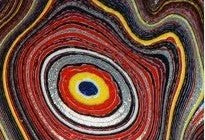
5 types of rough fordite
What is fordite?
Fordite is recycled automotive paint sourced primarily from automotive factories. It forms in thin layers as car parts are painted on the racks that hold them in place. The build up of paint eventually must be removed so that it doesn't impede the painting process. Fordite is considered industrial waste but due to it's incredible potential as a unique material for lapidary and jewelry making it can be very valuable. Paint booth workers are sometimes allowed to keep the paint chunks vs tossing it in the trash. This is how fordite makes it's way to artists and the general public. Not all factories or booths allow it to be kept which keeps the general supply of fordite over time low. Lots comes out of some plants (to the tune of hundreds of pounds) and none ever out of other plants. Compared to natural stone fordite is much lighter in weight.
Where does fordite come from?
Fordite occurs where mass painting of automotive parts takes place. There are many verified types of fordite on the market today including paint from the big three auto makers to smaller companies and parts manufactures. We've verified all the types we work with and with the big three we provide the factory location it came from in the individual listings. This allows you to know exactly what vehicles the fordite is from without us running afoul of trademark issues.
 Dragon Scale Fordite Rough
Dragon Scale Fordite Rough Why is fordite so expensive?
The value of a piece of fordite is related to supply, demand, intensity of colors, type and rarity. Some types are far more rare and valuable than others and that can drive the price up exponentially. I've been working with fordite professionally for 7 years. In that time types have come and gone from the market and new types have emerged. As a general rule what I've noticed is that even currently readily available types eventually disappear and then years later those types can be very valuable. The most valuable well known type now is the vette sports car fordite from Bowling Green KY. When I first started out it cost 15-35 cents per gram. Now it's up to anywhere from $1.25 - $4 plus per gram! I have a supply but at this price I haven't bought any in rough for many years and to respect its value I'll only set it in silver. What makes this type so valuable is a combination of the draw from this sports car, incredible colors and that it was only harvested for a short time in the late 90s to early 2000s. With fordite gaining in popularity what's available is being used up quickly.
 Layering in fordite.
Layering in fordite.
The big fordite myth:
When you search for information on fordite online misinformation abounds. The biggest myth is that fordite is all vintage and what's available is from factories that painted parts by hand in the old days of auto manufacturing. They'll tell you this means fordite is no longer occurring which is why fordite is rare and valuable. This is absolutely 100% false. Fordite is still occurring today and that's a great thing because with the supply over time consistently being small if it wasn't still being produced today it would have run out long ago and there wouldn't be any available to today's artists. The majority of automotive painting today is robotic which may in some instances produce less overspray and thus less fordite overall verses the old hand painting but there is still overspray especially with painting of certain parts and there are far more vehicles produced today than in the old days so there is still opportunity for fordite. Notice I didn't say "being made" there because fordite is incidental. Large parts like semi truck body panels and some bumpers are still in some plants painted by hand to this day. I've had auto workers send me pics and videos of how fordite forms in modern day applications. This myth is perpetuated due to outdated information on websites and blogs as well as some unscrupulous sellers who think saying their fordite is vintage somehow adds value to their products. With how quickly fordite is used there's very little actual vintage fordite on the market and so I'm honestly skeptical of most vintage claims regarding fordite. It does exist in minute amounts (like 1% maybe less of what's currently available). The actual antique/vintage fordite isn't something I work with due to the lead it contains but if you'd like a piece I know an artist that has it.
 Polished pieces of fordite
Polished pieces of fordite
Another fordite myth:
A recent online search brought up another myth I can debunk. It said if the fordite has very bright colors it's likely not real. I ran into this once from an artists blog in the past as well. At the time they were selling mostly pieces made from the Dearborn MI plant which has some color but not like the semi truck fordite or the Toledo Ohio Parkway plant stuff that had just emerged. They claimed at that time that all the more colorful newer stuff was fake. Fast fwd to present day and low and behold this and other artists who’d been perpetuating this myth are now selling the colorful modern types. I mean just look at the vehicles that came out of the Parkway plant, amazing colors! We're all super fortunate as artists to have access to this material.

How can I tell if my fordite real?
Good news! Most likely your fordite is real. Automotive paint is very expensiveto buy which makes creating fordite unrealistic. It costs more to make automotive fordite than to buy the real thing. It's possible to make a piece with spray paint but it's very time consuming, expensive and the paint does not harden like automotive paint so it’s not as easy to use. You'll hear about fordite being baked and think this may be what makes it good for cutting stones. Well I had the fortune to make some cabochons for an owner of one of the largest paint suppliers in the USA. I learned from him that new advances in paint technology have made baking the parts unnecessary in many automotive applications. I personally check online a couple times per year looking specifically for fake fordite. I sometimes will find some but thankfully the vast majority is real. Fordite will be lots of layers thick. Depending on how it’s cut and shaped they can appear as wide bands or very tight layers but each piece in some orientation will show the layering. The fake stuff looks more like poured paint and is often found in bead form.
Is fordite toxic?
In the late 1970s the state of California passed a law outlawing lead based automotive paint which resulted in the major manufactures removing it from their production lines. This is similar to what’s happening now with cosmetics. The power of the CA economy is such that it’s regulation can affect the manufacturing process of goods for the nation. If your fordite is pre 1978 odds are it's lead based paint. All of what I work with is modern fordite (post 1990) so it's not lead based paint. I also test every type I cut for lead before working with it. Modern paint does have other chemicals that can be harmful if ingested or inhaled when initially sprayed or sanded. The polished piece of modern fordite in your jewelry is safe to handle and wear in the same way that touching a car is safe but of course fordite should not be put in your mouth or eaten (it's still paint). For lapidary purposes I always cut fordite wet, wear a respirator, protective clothing, eye protection and wash my hands after cutting and polishing.

A common fordite deception to watch out for:
I've talked about how the vast majority of fordite is real and that should make you feel good but there are still scams to be aware of. The most common is what I call type fraud. This is where a person sells a common fordite type claiming it to be a rare and valuable type or a type that's never before existed. The biggest problem with type fraud is that when it originates with rough fordite sellers it then is unknowingly perpetuated by the lapidary who cuts stones from that rough as well as the the artists who then set and sell them in their jewelry. To someone who's worked with fordite as much as I have the common vetted types are readily identifiable by their colors and or the shapes of the rough fordite pieces. After cutting literally thousands of fordite stones I can tell the type of fordite a piece is made from at a glance. Unfortunately I've noted even sellers who work with lots of fordite are not always honest. I once reached out to someone peddling what they said was the valuable Bowling Green type but obviously wasn't. I figured they'd been hoodwinked by a rough seller and was just being friendly. Come to find out they knew it wasn't that type and were then angry that I contacted them and said I should "stay out of how they choose to run their business." Yikes, I'm not the fordite police! I was just trying to be helpful. I believe in karma and I've seen that most of those who knowingly do this sort of thing don't last long in this business. That said, some do, and still others are honestly unaware so for the layperson if you're concerned about ensuring your fordite is a specific type and it’s not clear ask what plant it's from. Narrow it down further if possible with the year make and model the paint is from and check the colors you see against the color charts for that vehicle from that year and the year prior (vehicles are often painted up to a year earlier than the release date). This is what I do when vetting a new fordite type from a big three or major auto maker. It's possible to have custom ordered colors in a piece of fordite but the majority of the colors should match the color charts. You can also search for that type of fordite and compare pieces from other artists. Look enough and you'll see the similarities. Just keep in mind those of us who make every effort not to use trademarked words to sell our art will not come up in these searches. I also sometimes see boatite, graffitite or surfite sold as fordite. These are similar to fordite and I work with them but they are not automotive so they're generally not considered fordite. More...fordite-esque. I’ll do blog posts on these materials as well in the future.

